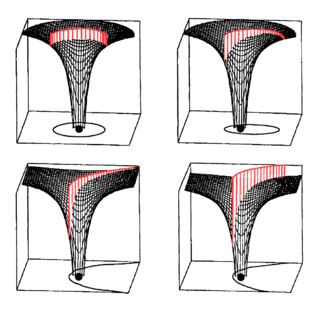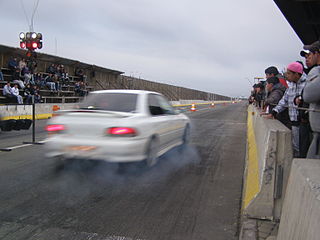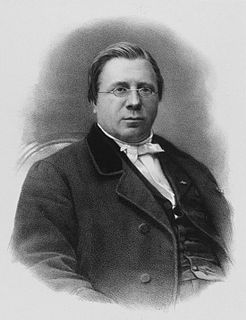
In physics, acceleration is the rate of change of velocity of an object with respect to time. An object's acceleration is the net result of all forces acting on the object, as described by Newton's Second Law. The SI unit for acceleration is metre per second squared (m⋅s−2). Accelerations are vector quantities and add according to the parallelogram law. The vector of the net force acting on a body has the same direction as the vector of the body's acceleration, and its magnitude is proportional to the magnitude of the acceleration, with the object's mass as proportionality constant.

In physics the Lorentz force is the combination of electric and magnetic force on a point charge due to electromagnetic fields. A particle of charge q moving with a velocity v in an electric field E and a magnetic field B experiences a force of

In physics, the Maxwell–Boltzmann distribution is a particular probability distribution named after James Clerk Maxwell and Ludwig Boltzmann.

Torque, moment, or moment of force is the rotational equivalent of linear force. The concept originated with the studies of Archimedes on the usage of levers. Just as a linear force is a push or a pull, a torque can be thought of as a twist to an object. The symbol for torque is typically , the lowercase Greek letter tau. When being referred to as moment of force, it is commonly denoted by M.
In mechanics, the virial theorem provides a general equation that relates the average over time of the total kinetic energy, ⟨T⟩, of a stable system consisting of N particles, bound by potential forces, with that of the total potential energy, ⟨VTOT⟩, where angle brackets represent the average over time of the enclosed quantity. Mathematically, the theorem states
Radius of gyration or gyradius of a body about an axis of rotation is defined as the radial distance of a point from the axis of rotation at which, if whole mass of the body is assumed to be concentrated, its moment of inertia about the given axis would be the same as with its actual distribution of mass. It is denoted by .

In physical science and mathematics, Legendre polynomials are a system of complete and orthogonal polynomials, with a vast number of mathematically beautiful properties, and numerous applications. They can be defined in many ways, and the various definitions highlight different aspects as well as suggest generalizations and connections to different mathematical structures and physical and numerical applications.

In physics, a force is said to do work if, when acting, there is a displacement of the point of application in the direction of the force. For example, when a ball is held above the ground and then dropped, the work done on the ball as it falls is equal to the weight of the ball multiplied by the distance to the ground. When the force is constant and the angle between the force and the displacement is θ, then the work done is given by W = Fs cos θ.

The moment of inertia, otherwise known as the angular mass or rotational inertia, of a rigid body is a quantity that determines the torque needed for a desired angular acceleration about a rotational axis; similar to how mass determines the force needed for a desired acceleration. It depends on the body's mass distribution and the axis chosen, with larger moments requiring more torque to change the body's rotation rate. It is an extensive (additive) property: for a point mass the moment of inertia is just the mass times the square of the perpendicular distance to the rotation axis. The moment of inertia of a rigid composite system is the sum of the moments of inertia of its component subsystems. Its simplest definition is the second moment of mass with respect to distance from an axis. For bodies constrained to rotate in a plane, only their moment of inertia about an axis perpendicular to the plane, a scalar value, matters. For bodies free to rotate in three dimensions, their moments can be described by a symmetric 3 × 3 matrix, with a set of mutually perpendicular principal axes for which this matrix is diagonal and torques around the axes act independently of each other.

In mathematics and physical science, spherical harmonics are special functions defined on the surface of a sphere. They are often employed in solving partial differential equations that commonly occur in science. The spherical harmonics are a complete set of orthogonal functions on the sphere, and thus may be used to represent functions defined on the surface of a sphere, just as circular functions are used to represent functions on a circle via Fourier series. Like the sines and cosines in Fourier series, the spherical harmonics may be organized by (spatial) angular frequency, as seen in the rows of functions in the illustration on the right. Further, spherical harmonics are basis functions for SO(3), the group of rotations in three dimensions, and thus play a central role in the group theoretic discussion of SO(3).
In mathematics, Green's theorem gives the relationship between a line integral around a simple closed curve C and a double integral over the plane region D bounded by C. It is named after George Green, though its first proof is due to Bernhard Riemann and is the two-dimensional special case of the more general Kelvin–Stokes theorem.

A circular orbit is the orbit with a fixed distance around the barycenter, that is, in the shape of a circle.
Virtual work arises in the application of the principle of least action to the study of forces and movement of a mechanical system. The work of a force acting on a particle as it moves along a displacement be different for different displacements. Among all the possible displacements that a particle may follow, called virtual displacements, one will minimize the action. This displacement is therefore the displacement followed by the particle according to the principle of least action. The work of a force on a particle along a virtual displacement is known as the virtual work.

Stokes flow, also named creeping flow or creeping motion, is a type of fluid flow where advective inertial forces are small compared with viscous forces. The Reynolds number is low, i.e. . This is a typical situation in flows where the fluid velocities are very slow, the viscosities are very large, or the length-scales of the flow are very small. Creeping flow was first studied to understand lubrication. In nature this type of flow occurs in the swimming of microorganisms and sperm and the flow of lava. In technology, it occurs in paint, MEMS devices, and in the flow of viscous polymers generally.
The gradient theorem, also known as the fundamental theorem of calculus for line integrals, says that a line integral through a gradient field can be evaluated by evaluating the original scalar field at the endpoints of the curve.
In astronautics, a powered flyby, or Oberth maneuver, is a maneuver in which a spacecraft falls into a gravitational well, and then accelerates when its fall reaches maximum speed. The resulting maneuver is a more efficient way to gain kinetic energy than applying the same impulse outside of a gravitational well. The gain in efficiency is explained by the Oberth effect, wherein the use of an engine at higher speeds generates greater mechanical energy than use at lower speeds. In practical terms, this means that the most energy-efficient method for a spacecraft to burn its engine is at the lowest possible orbital periapsis, when its orbital velocity is greatest. In some cases, it is even worth spending fuel on slowing the spacecraft into a gravity well to take advantage of the efficiencies of the Oberth effect. The maneuver and effect are named after Hermann Oberth, the Austro-Hungarian-born German physicist and a founder of modern rocketry, who first described them in 1927.

Lagrangian mechanics is a reformulation of classical mechanics, introduced by the Italian-French mathematician and astronomer Joseph-Louis Lagrange in 1788.
In classical mechanics, the central-force problem is to determine the motion of a particle under the influence of a single central force. A central force is a force that points from the particle directly towards a fixed point in space, the center, and whose magnitude only depends on the distance of the object to the center. In many important cases, the problem can be solved analytically, i.e., in terms of well-studied functions such as trigonometric functions.
The constants KM and Kv are values used to describe characteristics of electrical motors.




















